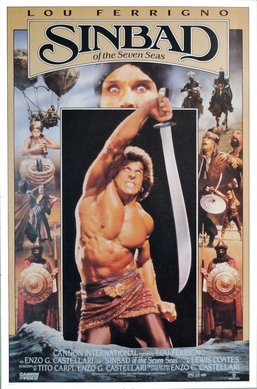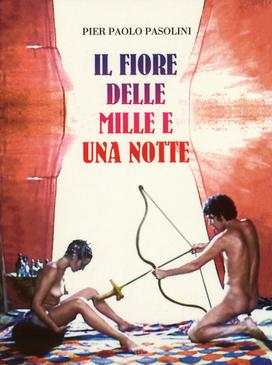
Sinbad the Sailor is a fictional mariner and the hero of a story-cycle. He is described as hailing from Baghdad during the early Abbasid Caliphate. In the course of seven voyages throughout the seas east of Africa and south of Asia, he has fantastic adventures in magical realms, encountering monsters and witnessing supernatural phenomena.

Sinbad of the Seven Seas is a 1989 Italian fantasy film produced and directed by Enzo G. Castellari from a story by Luigi Cozzi, revolving around the adventures of Sinbad the Sailor. Sinbad must recover five magical stones to free the city of Basra from the evil spell cast by a wizard, which his journey takes him to mysterious islands and he must battle magical creatures in order to save the world.

The Tale of Tsar Saltan, of His Son the Renowned and Mighty Bogatyr Prince Gvidon Saltanovich and of the Beautiful Swan-Princess is an 1831 fairy tale in verse by Alexander Pushkin.

Scooby-Doo in Arabian Nights is a 1994 made-for-television film produced by Hanna-Barbera Cartoons, and aired on syndication on September 3, 1994. It is an adaptation of The Book of One Thousand and One Nights and features appearances by Scooby-Doo and Shaggy Rogers, in wrap around segments.

Return to the Blue Lagoon is a 1991 American South Seas romantic adventure film directed and produced by William A. Graham and starring Milla Jovovich and Brian Krause. The film is a sequel to The Blue Lagoon (1980). The screenplay by Leslie Stevens was based on the 1923 novel The Garden of God by Henry De Vere Stacpoole. The original music score was written, composed, and performed by Basil Poledouris. The film's closing theme song, "A World of Our Own", is performed by Surface featuring Bernard Jackson. The music was written by Barry Mann, and the lyrics were written by Cynthia Weil.

The Twisted Claw is Volume 18 in the original The Hardy Boys Mystery Stories published by Grosset & Dunlap.

Arabian Nights is a 1974 Italian film directed by Pier Paolo Pasolini. Its original Italian title is Il fiore delle mille e una notte, which means The Flower of the One Thousand and One Nights.

The Golden Voyage of Sinbad is a 1973 fantasy adventure film directed by Gordon Hessler, featuring stop-motion effects by Ray Harryhausen. The film stars John Phillip Law, Tom Baker, Takis Emmanuel, and Caroline Munro. Based on the Arabian Nights tales of Sinbad the Sailor, it is the second of three Sinbad films released by Columbia Pictures, following The 7th Voyage of Sinbad (1958) and preceding Sinbad and the Eye of the Tiger (1977).

Sinbad the Sailor is a 1947 American Technicolor fantasy film directed by Richard Wallace and starring Douglas Fairbanks Jr., Maureen O'Hara, Walter Slezak, Anthony Quinn and Mike Mazurki. It tells the tale of the eighth voyage of Sinbad in which he discovers the lost treasure of Alexander the Great.

Sinbad the Sailor is a 1935 animated short film produced and directed by Ub Iwerks.

"Allerleirauh" is a fairy tale recorded by the Brothers Grimm. Since the second edition published in 1819, it has been recorded as Tale no. 65. Andrew Lang included it in The Green Fairy Book.
The Fool of the World and the Flying Ship is a made-for-television stop motion-animated film released in the United Kingdom on 27 December 1990 on ITV, based on the Eastern European folk tale. It was co-produced with WGBH Boston for broadcast on Long Ago and Far Away. The Fool of the World and the Flying Ship was released on DVD in the United Kingdom.
"The Three Sisters" or Green Meadow is an Italian literary fairy tale written by Giambattista Basile in his 1634 work, the Pentamerone. It tells the story of a maiden having secret encounters with a prince with the use of magic, him almost losing his life and her having to search for a cure for him.

Arabian Nights: Sinbad's Adventures is a 52-episode anime series directed by Fumio Kurokawa and produced by Nippon Animation which was first aired in 1975. The story is based on the children's story "Sinbad the Sailor".

Qurban is a Pakistani romantic Drama television series premiered on ARY Digital on 20 November 2017. The series is directed by Ahmed Bhatti, produced by Abdullah Seja and written by Zafar Mairaj under the banner of IDream Entertainment. It features Iqra Aziz, Bilal Abbas, and Shahzad Sheikh in Lead role.
"The Story of Prince Sobur" is an Indian fairy tale. It tells the story of a princess who summons into her room a prince named Sobur, or variations thereof, by the use of a magical fan. The story contains similarities to the European (French) fairy tale The Blue Bird, and variants have been collected from South Asia and in Eastern Africa.
The Horse Lurja is a Georgian folktale published by Georgian folklorist Mikhail Chikovani. It tells the story about the friendship between a princess and a magic horse, which sacrifices itself for her after it rescues her from great peril. Although the tale appears in Georgia, some scholars recognize similar narratives in Central Asia and across Europe.
The Story of Lalpila is an Indian folktale collected from the Baiga people by ethnologist Verrier Elwin. It is related to the cycle of the Calumniated Wife, and is classified in the international Aarne-Thompson-Uther Index as tale type ATU 707, "The Three Golden Children".
Maria is the title given to a Filipino version of Cinderella collected by Fletcher Gardner and published in The Journal of American Folklore, in 1906. The story is related both to the international Cinderella narrative, as well as to the motif of the calumniated wife.













